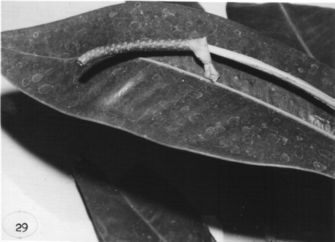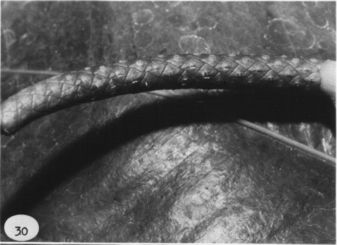





TYPE: Panama. Panama: El Llano-Carti Road, 10 mi. from Pan-American Hwy. near El Llano, 330m, Croat 33803 (MO 2815426, holotype; B, F, K, PMA, UC, US, isotypes; Live at MO).
Epiphyte; stems less than 20 cm long, ca. 2 cm diam.; roots dense, green, descending; cataphylls coriaceous, 4-5 cm long, acute at apex, drying dark brown (B & K Yellow 4/2.5), weathering to persistent fibers.
LEAVES spreading; petioles 10-22(-30) cm long, 4-5 mm diam., subterete, sharply and shallowly sulcate, faintly ribbed medially, the sides flattened and parallel to one another; geniculum 1-1.5 cm long; blades oblong-elliptic, moderately thick, acuminate at apex, obtuse to rounded at base, 10-33 cm long, 4.5-8.5 cm wide, broadest near middle; upper surface semiglossy, eglandular, lower surface much paler, matte, densely glandular-punctate; midrib convexly raised above and below, diminishing and sunken at apex above; primary lateral veins 10-16 per side, departing midrib at 30° angle, merely etched in surface of blade above, pro-minulous below, straight to collective vein; lesser veins obscure above, prominulous below; collective vein arising near the base, etched above, prominulous below, 3-6 mm from margin.
INFLORESCENCE spreading, sometimes shorter than leaves; peduncle 34-47 cm long, 4-5 mm wide, triangular, sometimes 2-5-ribbed or winged, often twisted, sometimes tinged red-violet, 2-5 times longer than petioles; spathe medium thick, green (B & K Yellow-green 8/10), sometimes faintly tinged red-violet, oblong-lanceolate, 4.3-4.5 cm long, ca. 1.8 cm wide, broadest at base, acuminate at apex, rounded to truncate at base, spreading at a 90° angle, twisted longitudinally and turned up near apex, inserted at 50° angle on the peduncle; spadix green or green tinged purplish (B & K. Yellow-green 4/10-5/10), 5.5-8.5 cm long, 5-8 mm diam. at base, 3-4 mm diam. at apex; flowers square, 3-4.5 mm long, 2.8-3.8 mm wide, the sides straight to gradually sigmoid, ca. 5 flowers visible in the principal spiral, ca. 7 flowers visible in the alternate spiral; tepals semiglossy, minutely papillate, lateral tepals 2.3-3 mm wide, the inner margin straight; pistil slightly raised, green becoming dark purple or green tinged dark purple; stigma linear, 0.4-0.5 mm long, green, minutely exsented, moist with minute droplets ca. 3 days before stamens emerge; stamens emerging in a regular sequence beginning at the base, laterals first quickly followed by alternates, the first lateral retracting below tepals as first alternate emerges; anthers pale green, completely retracting beneath tepals, leaving traces of white pollen.
INFRUCTESCENCE not seen; berries probably lavender. Figs. 29
and 30.
Anthurium cartiense is endemic to Panama and is known only from the El Llano-Carti Road in Panama and from the Santa Rita Ridge in Colón Province east of the previous Canal Zone.
The species is a member of section Porphyrochitonium and is closely related to Anthurium crassiradix with which it shares somewhat oblong, glandular-punctate (lower surface only), subcoriaccous leaf blades and an elongate, three-sided, somewhat winged peduncle that usually greatly exceeds the petiole. Anthurium crassiradix differs in having a slender, much more elongate spadix and blades that are commonly broader below the middle, frequently with a well-developed secondary collective vein and the tendency to become subcordate in age. Anthurium cartiense diners from A..crassiradix in having a short, weakly tapered spadix and blades that are broadest in the middle.
An unusual feature that may be shared by both species is the much thickened coralloid mass of roots. I have seen this species only once in the field and did not make a note of this character on Anthurium cartiense, although it was present on specimens of A. crassiradix. However, one collection of A. cartiense (Nee 7916) notes the presence of such roots.
 |
 |
Map of Mesoamerican specimens with coordinates
Panama Colón: 300-400 m, 9.24N 79.39W, 25 Sept. 1980, Sytsma 1322 (MO).
Panama Panamá: 350 m,, 15 Feb. 1975, Mori et al. 4708 (MO). Panama Panamá:
200-500 m,, 20 Feb. 1973, Kennedy 2509 (MO). Panama Panamá: 330 m,, 28
Mar. 1976, Thomas B. Croat 33803 (MO).